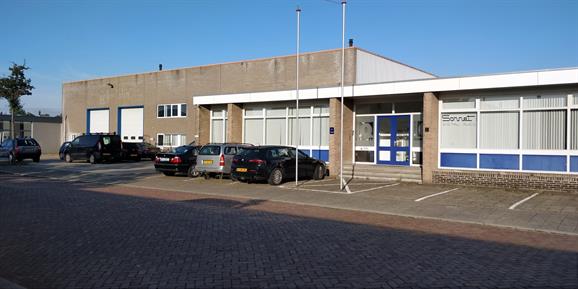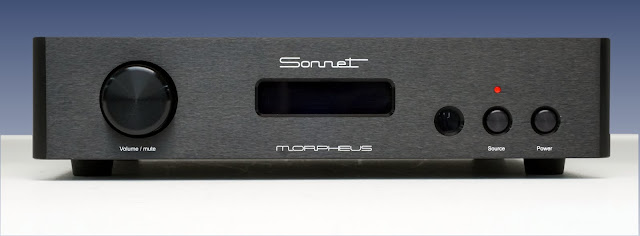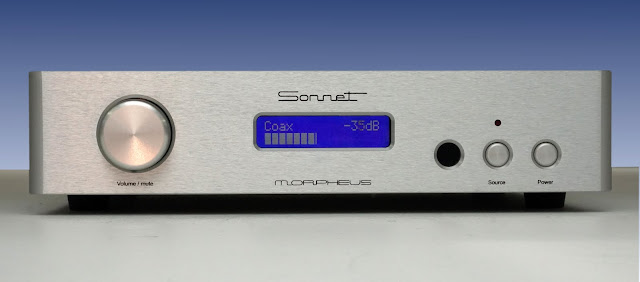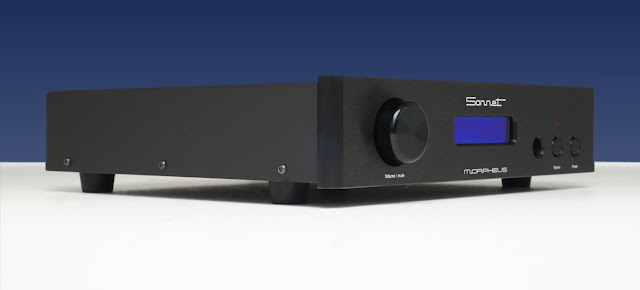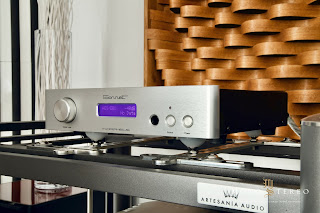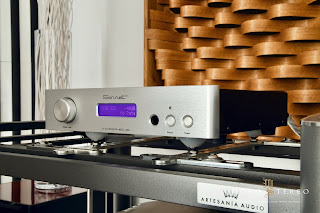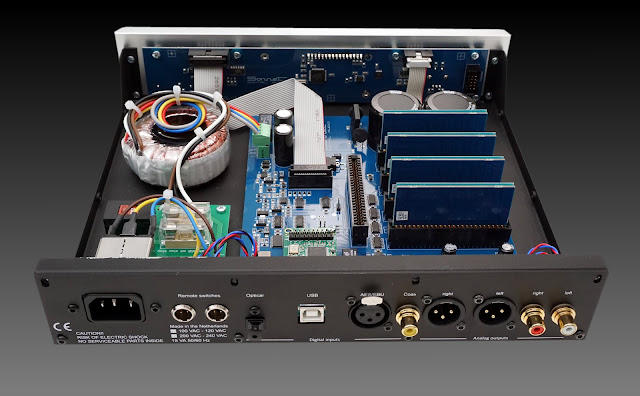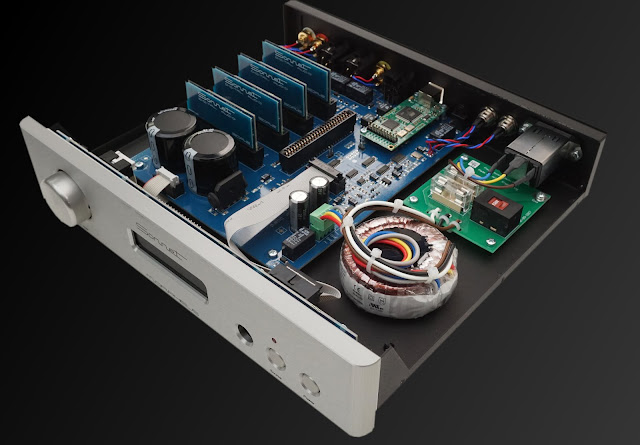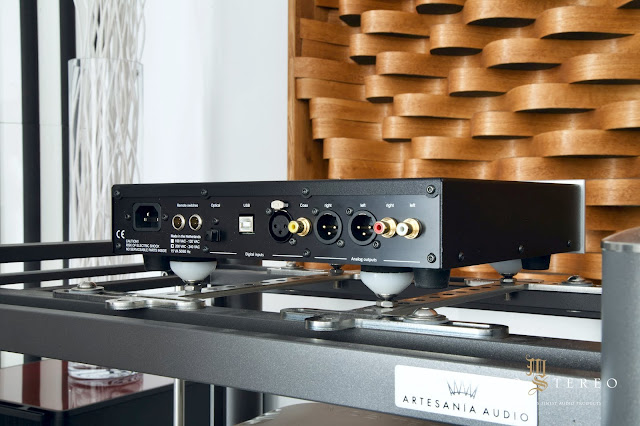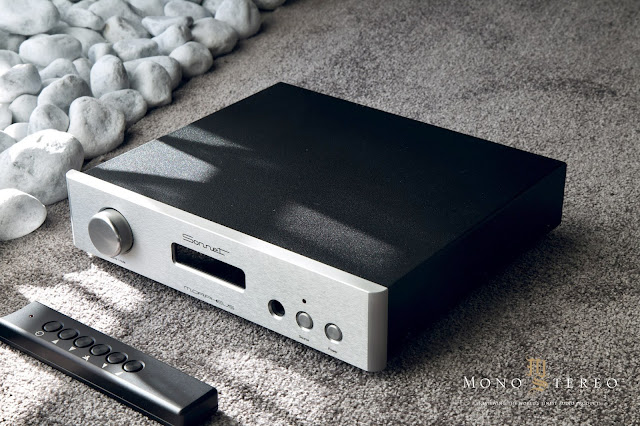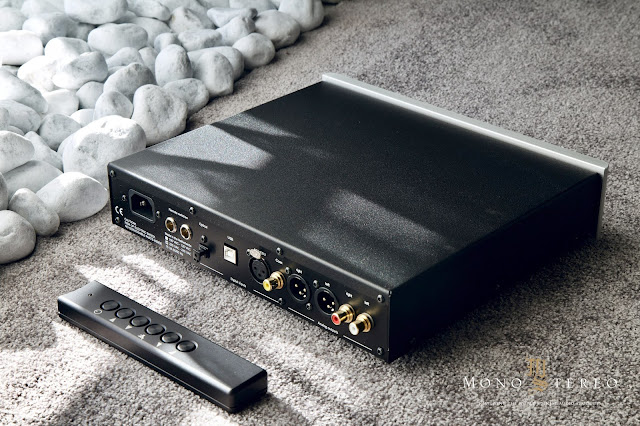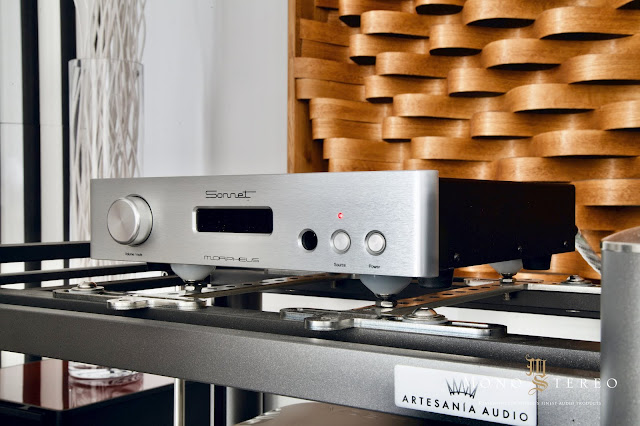
I have a pretty long tracked experience with Metrum Acoustics Adagio DAC and really liked it’s sonic balance and potent core. It was more than interesting to explore Ruijtenberg’s new venture’s latest DAC and what it can deliver the digital domain.
Sonnet Digital Audio Morpheus continues the legacy set by Ruijtenberg’s previous products at Metrum Acoustics and for Sonnet Digital Audio he went back to the drawing board and created something that goes beyond expectations…
TECHNICAL HISTORY
THE INITIAL GOAL
FILTERING
THE SPEED!
MEET THE SONNET MORPHEUS
OPERATIONAL
I’m more or less Mac OS based so no additional USB drives were needed for the installation. The same goes for Linux. For the PC (and the rest of drivers) Sonnet Digital Audio recommend the download directly from the Amanero.
Everything around the Sonnet Digital Audio Morpheus is straightforward and easy to use and I didn’t experience any hiccups with the USB input during the evaluation.
The front panel is made out of a thicker plate of aluminum. On the left side, there is a large volume knob. The middle is occupied by the LCD and on the right, there is the remote input lens followed by source selection and power knobs. The menu settings are accessible by pressing both source and power buttons simultaneously.
When the Morpheus is switched on for the first time the volume is set to -40dB. This will be repeated every time that Morpheus is switched completely off the grid and the power cable is removed. This prevents the extreme volume level output when it’s used as the preamplifier.
The volume control uses a rotary encoder, that has no has no end stops like a normal potentiometer. By turning the volume knob, the output level changes in steps of +/- 1 dB.
By reaching -64 dB level Morpheus automatically switches to mute mode. The volume level indicated on the front panel is displayed by the exact Decibel level and a thermometer scale.
By default, the Morpheus is pre-set to the variable volume, but it’s partnered with analog preamplifier it can be set in the menu to a “Fixed mode”, where fixed level is based on the last volume setting. So in case that the volume level was set for -10dB Morpheus can be used as a normal DAC with a -10dB fixed level. This setting is stored in the memory even if the DAC is disconnected from the mains.
On the back panel, there are optical, coaxial, AES/EBU and USB input and RCA/XLR outputs. The far left is reserved for the IEC input and next to it are the remote switches, that can be used for the remote triggering. Optionally I2S module can be installed instead of the USB module free of charge.
The “Morpheus” is designed to conform to the “Red book standard” and the maximum output is 2 Volts RMS for RCA and 4 Volts RMS for XLR.
DSP functions Options like MQA or other DSP modules are detected automatically when installed but can be bypassed in the menu. By default, the “MQA/DSP” option is switched to “On”.
THE MUSIC
While going through my favorite reference music the Sonnet Digital Audio Morpheus somehow felt more like an old friend, rather than a newly met stranger. So many traits were familiar with a few introductions that pushed me to the exploration of far deeper realms than expected and made me rethink some of the fundaments.
Morpheus could drive my Lamm M1.2 Reference with ease and properly displaying the music, track after track, album after album. Lamm’s hybrid heart established lock and load synergy with an interesting and inspiring distribution of the music’s energy. Digital can be too quickly confined for sounding too sterile and lifeless. While Morpheus has never stepped into the brittle realms when partnered with other power amplifiers the Lamm’s combo did make it sing particularly well.
Morpheus chameleon-like nature could render both radiancy or paleness at the same degree and without being assertive.
As always, there is neither enough time nor space to capture all of the insights and reference tracks, but here are some most prominent from the listening notes.
I’m always happy to learn about Cowboy Junkies’ new music. The all-new album release came sort as a surprise as it was planned to be released as a very limited edition, double audiophile album created from the remastered and recut version of All That Reckoning album released in 2018, that would feature a second disc with the all-new music, called Ghosts. Cowboy Junkies have the test pressings that they sound beautiful, but with the complicated logistics, they are delaying the release of the vinyl (there will be no CD) until the things get back to normal.
Like with most of their albums there is deeper about the Cowboy Junkies’ music. The maturity and captivating rawness of the Ghosts assure the unmistakable voyage, a leitmotif safe side of melancholy.
I’ll have to wait for the vinyl release to hear “the other side” of the spectrum, but streaming format already provides a lot to enjoy and to fully immerse in the music. All the tracks are familiar and share the recognizing narrative, but I’ve found an instant connection with “The Possessed”. In all it’s the simplicity it got that familiar Robert Johnson’s grit.
With DACs it’s not all about resolution and transparency. These two might be among the fundaments but cannot stand solely on their part as foundation. Morpheus inner core is most translucent, but it also managed to establish the harmonic balance and sonic vitality way past what I’ve expected and what I’ve heard so far in this price range.
“The Possessed” didn’t fail to impress with Sonnet Digital Audio DAC. Margo Timmins’s vocals were shaped with no lack of airiness and ethereal nub! A feat alone worthy of all the high praise and so was the sense of epitomized realism.
The complexity of emotions is for sure among Cowboy Junkies’ forte leitmotifs and Morpheus’ powerful nucleus allows it to unfold with a lingering effect. I’m either moved emotionally or not and unlike many DACs regardless of the price, the Sonnet Digital Audio did not hold back the emotional interaction at any point.
Morpheus’ ability to paint palpable and vibrant sonic palette was further confirmed with masterfully crafted “Touch Me Fall” from the album Swamp Ophelia composed and performed by Indigo Girls.
Here the rawness and pure energetic collision step up to a new level. The complete track is an emotional and dynamic rollercoaster, yet the epic outro will and should impress, but it demands an enormous power delivery and draws a very last bit from the front end. Morpheus’ ability to render sheer weight, tonal correctness let far more than a wishful lurking into the sonic scenery and far greater emotional impact than expected. I surely didn’t imagine for dimensionalities of space to exhibit such grand expanse.
Another favorite of mine is Mia Žnidarič, Steve Klink Trio “Počasi” from the album Pobarvanka. This splendid collage of Steve Klink’s arrangements is indeed a color book (literal translation) that uniquely capture the soul of Feri Lainšček’s verses.
The interplay between Žnidarič’s vocal and Klink’s piano it’s of heavenly realms and so its the song arrangement unmistakably and expertly captured and mastered by Janez Križaj. One can easily just follow the piano riff that extends and modulate through the song or leave or about forget the time and space by immersing into the Žnidarič’s vocal so deeply etched by the Billie Holiday, Ella Fitzgerald, Sarah Vaughan, Dinah Washington, etc.
Morpheus followed the slowed paced unveiling of “Počasi” (Take it slowly) with authority and needed amount of acoustical anchor points that let this remarkable song to reveal with a fully sketched tale.
Adam Ben Ezra – Can’t Stop Running is a bit more upbeat sonic kaleidoscope with a tight groovy march. I like and love how well the complex composition are evenly distributed with Morpheus, having no problem whatsoever to follow the rhythm or to recreate the aural scenery and instruments with tangible objectivity.
“Like Someone In Love” by Beets Brothers from album Beets Brothers Live in Holland additionally established how Morpheus can and will display needed density of a live performance without taking away any of the subtleness.
The same goes for Morpheus ability to enchant… Kazuma Fujimoto “Polynya” from the album Flow is a subtle excursion into the lyrically enriched work of Fujimoto. For the “Polynya” full discourse the front end needs far more unabridged and comprehensive inter-workings than the usual gauge. Surprisingly the Morpheus DAC permitted not only harmonically dense rendering… It’s distinguished inner core granted the music to expand on the spur of the moment, far beyond the speakers, both horizontally and vertically. My reference listening room was designed from the ground up to allow the grander sonic stretch and the source potency is swiftly revealed with a few known reference music tracks.
Morpheus higher grade acoustical anchor points are far denser that they should be for it’s given price and this tells a lot about its value. There is nothing entry level about the sound and nothing one can tie with its given price tag.
Ju Won Park’s “Caval” from the album Captain shifts the mood to a flamenco alike quantity of motion, but with what a twist of its own.
The mediocre front end will replay the bottled spirit. The music captured in the DAC’s electronic and mechanical form. Letting the spirit out of the machine takes know-how and far greater understating of circuits’ inner-workings and this is where Morpheus differs and easily stands out of the crow.
Byungki Hwang The Best of Korean Gayageum Music “Darha Nopigom, for 17-string gayageum & janggu: Reverently” strips away anything unneeded and presents a purely musical form with gayageum, a Korean 17-string classical instrument and Janggu traditional drum with the hourglass-shaped body.
Sonnet Digital Audio Morpheus DAC could weave together the notes, overtones and drum strikes in an immersive tapestry that is not easily achieved regardless of the price. When the digital front end is capable of creating such a saga, unabridged sonic experience with the music like “Darha Nopigom”, this is by all means and extraordinary achievement.
If any of the high-end audio products can help to evoke both external and inner images so lucidly as Sonnet Digital Audio DAC can, this should be noted as a non-ordinary achievement. All of my listening notes repeatedly pointed out this Morephus particular qualit. A combined virtues of lab like loop magnification in absence of digital artefacts at the microscopic level and holographic radiant three dimensionality with a startling believability factor.
CONCLUSION
Then again, we are operating with two buts… We’re living in a very different world where higher-order high-end audio reproduction is not merely reserved for a few selected, privileged individuals and Cees Ruijtenberg is no ordinary audio engineer!
It was never been a better time to be in high-end audio than presently. Not only we have an unimaginable amount of music at the tip of our hand. We also have an opportunity to shop wisely if needed and wanted. Yes, there will always be higher-priced products with the stronger than imagined customer base, but I’m more than happy to report on both accounts. People seem to forget how interlinked is our niche market. What might appear as segregated its cross-connected momentum on so many fronts!
The high performing more affordable devices ignite the interest and in due time there is always some percentage of progression upwards to more expensive products. The higher-priced, properly designed products will always capture the imagination of a larger audience. Even if people cannot afford them, similar to the cars and watch industry, they are still interested in reading about them.
Technological progress is not firmly bound to the trickled down technology coming from cost no object products. The Sonnet Digital Audio Morpheus is an exemplary proof that it can work the other way around too. By forwardly moving up on the ladder. So for those of interest a pricer, upper echelon Sonnet Digital Audio DAC is already in the pipeline, although it’s not coming so soon.
If feels how Morpheus sounds faster, snappier and more resolving compared to the Metrum Acoustics Adagio, letting the more info and details to unveil. How so?
The reference voltage acts the same as with Metrum Acoustic Adagio, but the biggest changes with Morpheus are the DAC chips along with new R2R ladders, new algorithms and very short tracks in the DAC modules. Additionally, there are four ladders instead of two as used in the Adagio. That is for one DAC module, so factor x4 makes the 16 ladders.
The FPGA in the center of these four ladders runs at 400Mhz and the current to voltage section has a slew rate of 180 V/uSec! That answers the speed part… Due to the new ladders and FPGA, the power is reduced by a third. That means lower currents and therefore lower radiation of the tracks resulting in a lower noise floor of -155dB related to 2 Volts red book standard.
To give the Morephues preamplifier section fair stress I’ve set up my The Bespoke Audio Company Ultimate Silver passive preamplifier that I’m using as a reference preamp as it comes to close proximity of what is considered the straight wire gain concept. All the preamplifiers that are coming in for the evaluation always undergo such contrasting test that allows me to properly judge how it was voiced at which sonic direction it took compared to optimum epicentre.
Interestingly, Morpheus’ unique approach of dealing with the volume gain came out as sobering, stand out act of purism and transparency put in practice. Morpheus has exhibited an extremely low self imprint without the usual electronic or mechanical traces that is the usual affair with preamplifiers regardless of what principle is adopted. Those among you who are seeking for the DAC without additional preamp do pay attention and mark this particular feature in the Wishlist’s highlights!
The way that Morpheus handles the gain left a strong mark on me. In high-end audio people are exploring a different kind of -isms and the Morpheus is an avid representative of purism! I’m not talking about purism that follows the clinical and analytical path. What I’m referring to is the purity that looks back at keeping the signal intact as much as possible.
As with anything in high-end audio, also the DACs are not prone to the voicing part in due course of the design. Willingly or unwillingly, this is consequential to the deliberate or non-deliberate engineer s’ design choices.
And Morpheus is a no different affair. It was clearly voiced and it was voiced in a proper manner. Even the purism itself can take many different turns with contrasting approaches. Ruijtenberg has cleverly blended needed resolution and natural warmness into a harmonic whole that look-upon the real world, uncut qualities of the music.
The Morpheus R2R DACs in conjunction with variable gain might be one of the most hidden and overlooked concepts out there. Many have missed unique features of Metrum Acoustics Adagio, yet now at almost half of the price and with a sonic step-up the Morpheus is as and should be as tempting as it gets…
Having so much quality on the plate at such down to earth world pricing surely feels like a mind-boggling matter. Then again… We’re living in the 21st century where rapid evolvement of technically profound products increases exponentially. With the devices like Sonnet Digital Audio Morpheus our beloved, yet compared to the computer or mobile phone industry, still quite niche industry, is finally blooming in the right sense of the word, and even more importantly it’s taking the right direction.
Dream on dreamer!? Morpheus’ name refers to the demigod that is associated with sleep and appears in the dream in the human form. As the Sonnet Digital Audio DAC’s particular name picking was surely no happy accident.
 Morpheus’ origin also refers to form and shape, and forming a believable, human (life-like) illusion is unquestionably Morpheus’ raison d’être.
Morpheus’ origin also refers to form and shape, and forming a believable, human (life-like) illusion is unquestionably Morpheus’ raison d’être.
Listening to the Sonnet Digital Audio Morpheus feels rather like a consciousness voyage in the lucid dream, than the usual stream of unconsciousness affairs. Morpheus allows a unique sonic Immordino where music is at forte and not pushed behind the technicalities or saturated realms.
This review and evaluation were more than just a pleasant encounter with Ruijtenberg’s proud creation. Morpheus pushes the boundaries of digital not only by its price tag but by its sheer performance. It represents a serious challenge to the highly competitive high-end audio segment and it should make quite a few manufacturers nervous, push them back to the drawing board!
For what it represents Sonnet Digital Audio Morpheus deserves to receive a rare but well-deserved recognition in a form of 2020 Mono and Stereo Upper Echelon Product award.⧉
PRICE
- Consumer price in Europe Euro 3500 21% VAT included
- Consumer price rest of the world Euro 2895
TECHNICAL SPECIFICATIONS
- Back Balanced non-oversampling DAC
- Two SDA-2 DAC modules per channel in differential mode
- Power supply 15VA 110/115V AC 220/230V AC 60/50Hz. Power required max 8 Watts
- Input 1x optical, 1x coaxial and 1x AES/EBU and USB
- Output 1x stereo pair single-ended 2 Volts RMS
- Output 1x stereo pair XLR balanced 4 Volts RMS
- Frequency Response 44.1 kHz sampling 1Hz – 20 kHz -2.5 dB
- Frequency Response 192 kHz sampling 1Hz – 65 kHz – 3dB and 384kHz (USB)
- Distortion 0.004% THD
- Channel separation 120dB
- Noise Floor -155 dB related to 2 Volt RMS
- Output impedance RCA 100 Ohm, XLR 100 Ohm
- Sampling rate Optical 44.1 – 96 kHz
- Sampling rate Coax and AES/EBU: 44.1 -192 kHz
- Sampling rate USB 44.1 – 384kHz
- MQA module (standard not included)
- I2S Module can be installed instead of the USB module free of charge.
